National Servicemen’s Nominal Roll Comes to Anzac Square
By Alaine Baldwin, Anzac Square Memorial Galleries | 19 December 2023
Have you noticed that the National Servicemen’s Nominal Roll can now be accessed through the Anzac Square website? This important document has been compiled by the National Servicemen’s Association and as Queensland’s pre-eminent war memorial we are honoured to have added it to our website so that it can remain accessible to the public.
So, what was National Service and who are the Nashos?
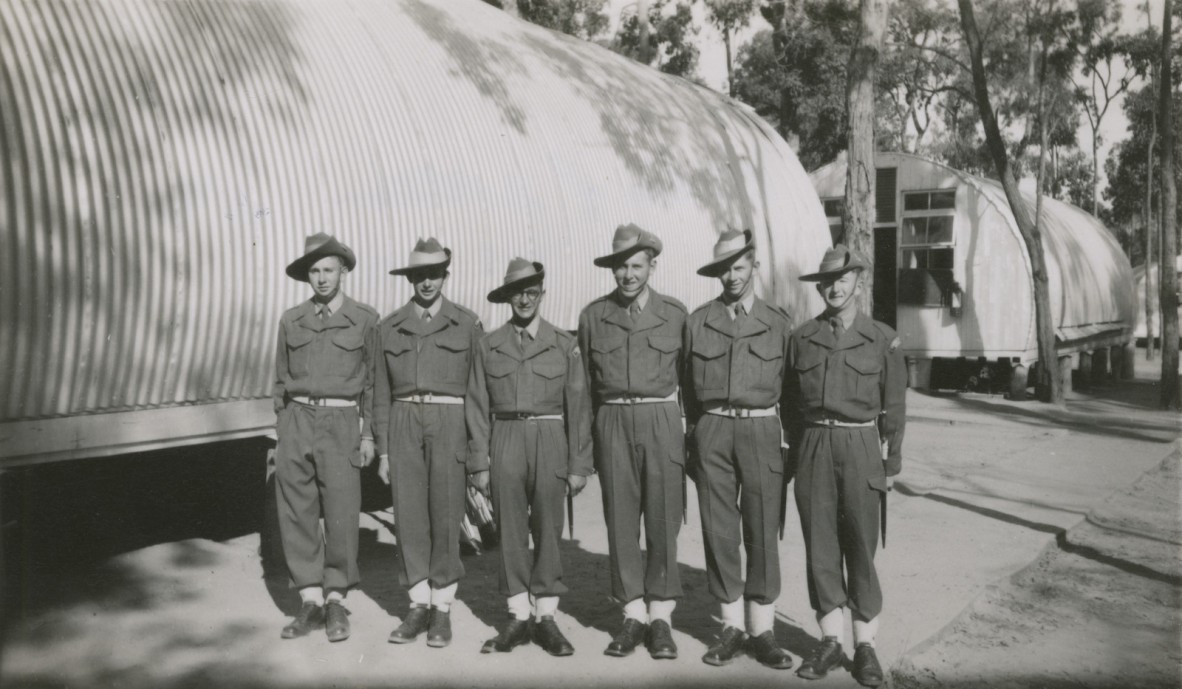
National Service Recruits from 2nd Platoon A Company, standing in front of their platoon hut at Wacol, 1953, 32652, Bill Porter National Serviceman Photographs, State Library of Queensland.
National service is compulsory service in the military. Australia has a long tradition of national service, with four separate national service schemes dating back to the early years of the 20th century. Conscription ended at the end of WWII but as part of Australia’s preparedness a new compulsory training scheme was introduced in 1951. The more than 290,000 national servicemen who served between 1951-1972 under the two separate schemes are affectionately known as the Nashos.
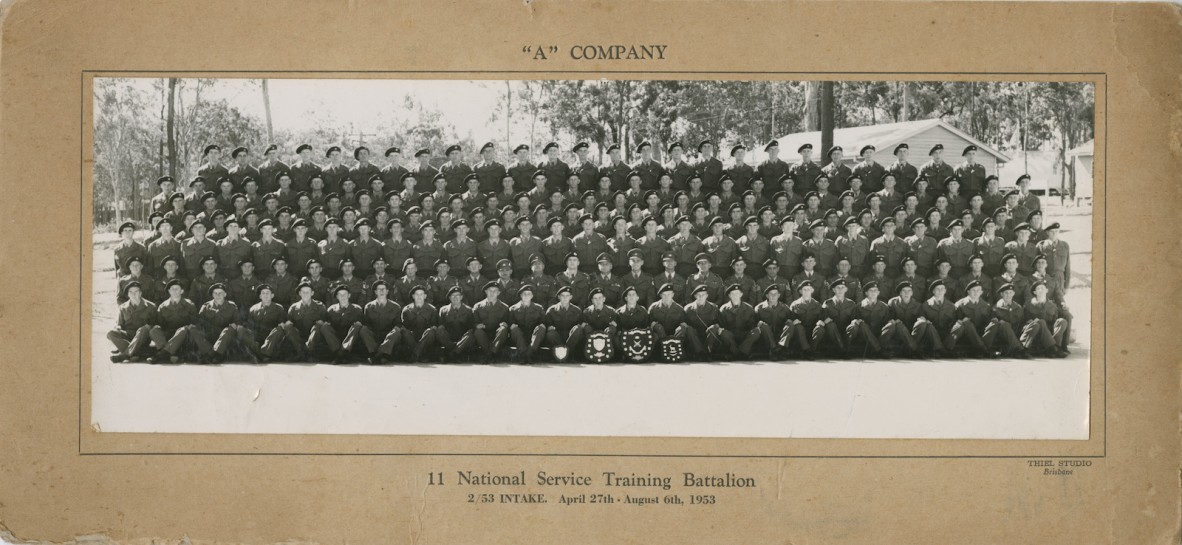
Group photograph of A Company, 11 National Service Training Battalion, 2nd intake in 1953, 32652, Bill Porter National Serviceman 1953 Photographs, State Library of Queensland.
National Service Scheme: 1951-1959
Influenced by the outbreak of the Korean War in 1950 and the Cold War tensions at this time, the Menzies Liberal government brought back compulsory military training in 1951. Under this National Service Scheme, eligible 18-year-old men had to undertake 176 days (about 6 months) of continuous service and then 5 years in their respective reserves. However, this did vary between Services as the scheme progressed. Of the 500,000 who registered, 227,000 were called up. While they could nominate a Service preference when signing up, in reality most were allocated to units near their homes. Overseas service was mandatory for the 7,000 Navy and 22,000 Air Force recruits but not for the 198,000 Army servicemen, though most of them were prepared to go. None of the National Servicemen in this scheme would see active service. National Service in the Navy and Air Force had ceased in 1957 and the entire scheme was discontinued on 24 November 1959. All Nashos in this scheme were declared to have honourably discharged their service obligation as of 30 June 1960 when a special 'Release of National Service Act' enabled automatic discharge rather than having to see out their five years.
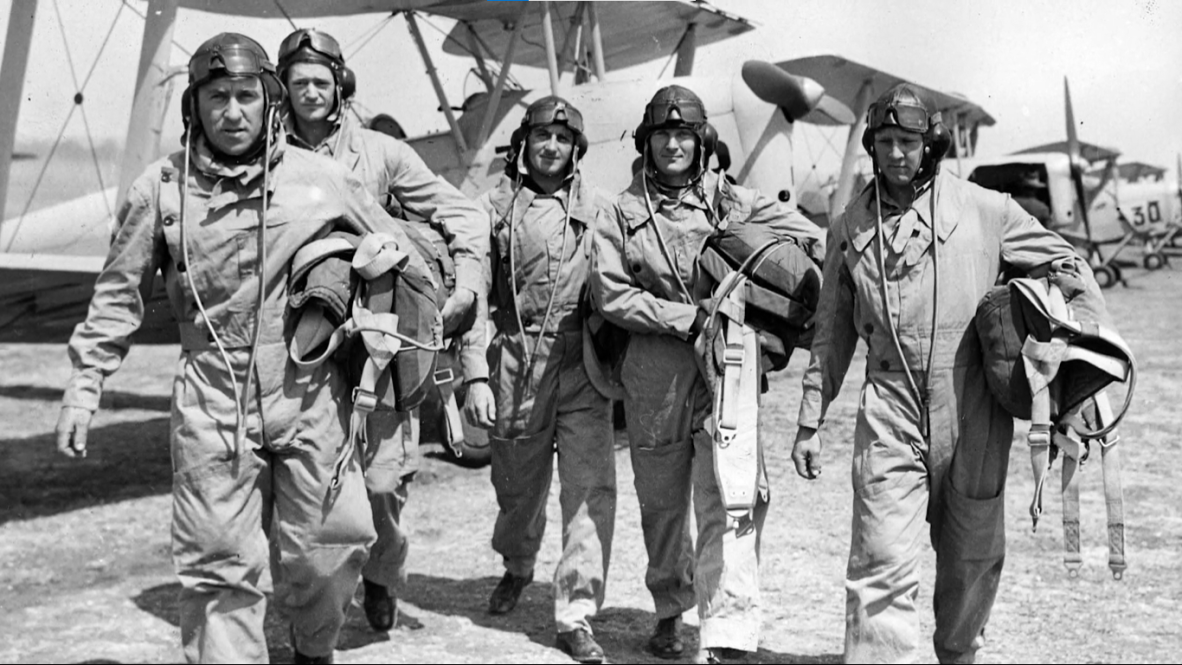
National Service Air Force recruits during flying training including John Tate National Serviceman 1951-1952, 2020 Screenshot from John Tate Digital Story and Oral History, Santolin, Jeremy (Producer), State Library of Queensland.
Second National Service Scheme: 1964-1972
The last National Service Scheme was introduced in 1964 when conflicts in Southeast Asia and Vietnam raised fears about Australia’s security. The National Service Bill became law in late 1964, with new powers introduced in May 1965 enabling the Government to send conscripts overseas. Selection for military service was held twice a year and was based on a birthday ballot for 20-year-old men. If your birthday was drawn from the ballot and you met the security and fitness criteria you could be selected to serve two years in the Army (reduced to 18 months in August 1971) then three years part-time in the Army Reserve.
From 1964 until it was abolished by the Whitlam Government on 5th December 1972, more than 804,000 men registered for National Service. Over 63,000 of these were called up to serve and more than 15,300 of them would serve in the Vietnam War, and the remainder served in support units in Australia, Malaysia and Papua New Guinea. 1688 National Servicemen completed Officer Training and were commissioned as 2nd Lieutenants, while 600 who were teachers were promoted to sergeants and posted to PNG for twelve months to educate soldiers of the Pacific Islands Regiments. These men became known as the ‘Chalkies.’
The 1965 amendment to the Defence Act stated 'conscripts could be obliged to serve overseas' and in March 1966 then Prime Minister Holt announced, National Servicemen would be sent to Vietnam to fight in units of the Australian Regular Army. Consequently, most National Servicemen (Nashos) were not given the choice of active service once allocated to a regular army unit, especially infantry units. As a result, 2 died in Borneo and in the Vietnam War 210 were killed and more than 1200 were wounded.
The Vietnam War was the cause of great social and political dissent in Australia similar to what was seen during the conscription referenda of the First World War. These domestic divisions over the Vietnam War saw National Servicemen, particularly those who had seen active service, in the undesirable position of having been conscripted by a selective ballot and then subjected to open disdain by some of the Australian public.
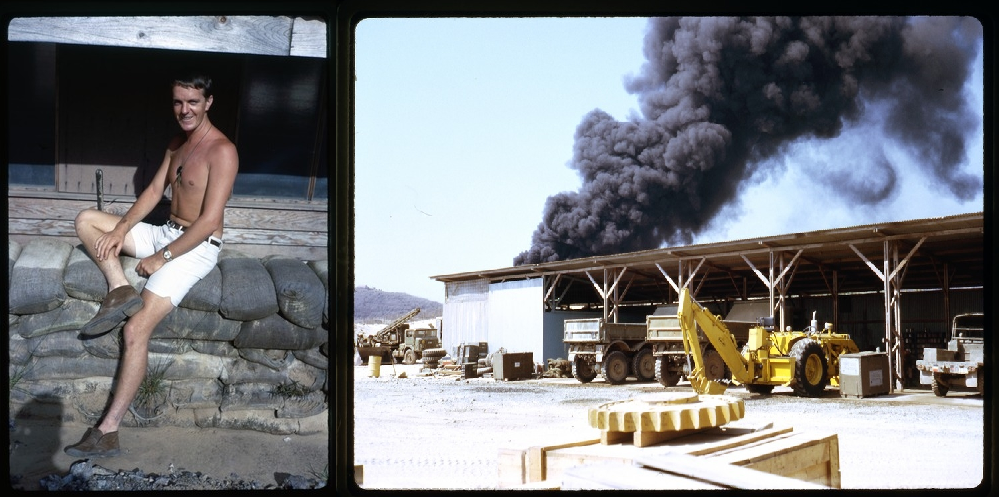
David Kelly was conscripted into National Service and served in the 17th Construction Squadron in Vietnam from 1968–1969. David’s primary responsibilities within the squadron were machine maintenance of bulldozers, graders, trucks and land rovers. 31613 David Kelly Slides of Australian Servicemen in Vietnam, John Oxley Library, State Library of Queensland.
Recognition at last:
In 1987 Barry Vicary, a 1965 Nasho and Vietnam veteran, founded the National Servicemen’s Association of Australia in Toowoomba, Queensland. The purpose of this organisation was to seek a better deal for National Servicemen and petition for a medal recognising their service. Unfortunately, Barry would not live to see his medal as he passed away in 1991 and it was not until 2001 that the Government awarded the ‘Anniversary of National Service 1951-1972 Medal’ in recognition of the contribution of National Servicemen to Australia’s defence in time of need.
On 8 September 2010, thousands of former National Servicemen gathered in Canberra to witness the official dedication by the Governor-General of their new memorial fountain located in the Eastern Precinct of the Australian War Memorial. National Servicemen’s Day (no women served in the National Service) commemorates and honours those who served Australia through compulsory military training. It is held on 14 February, which some say marks the day the first Nasho marched into a training camp in 1951 while others maintain it is the day the last Nasho completed his Army obligation.
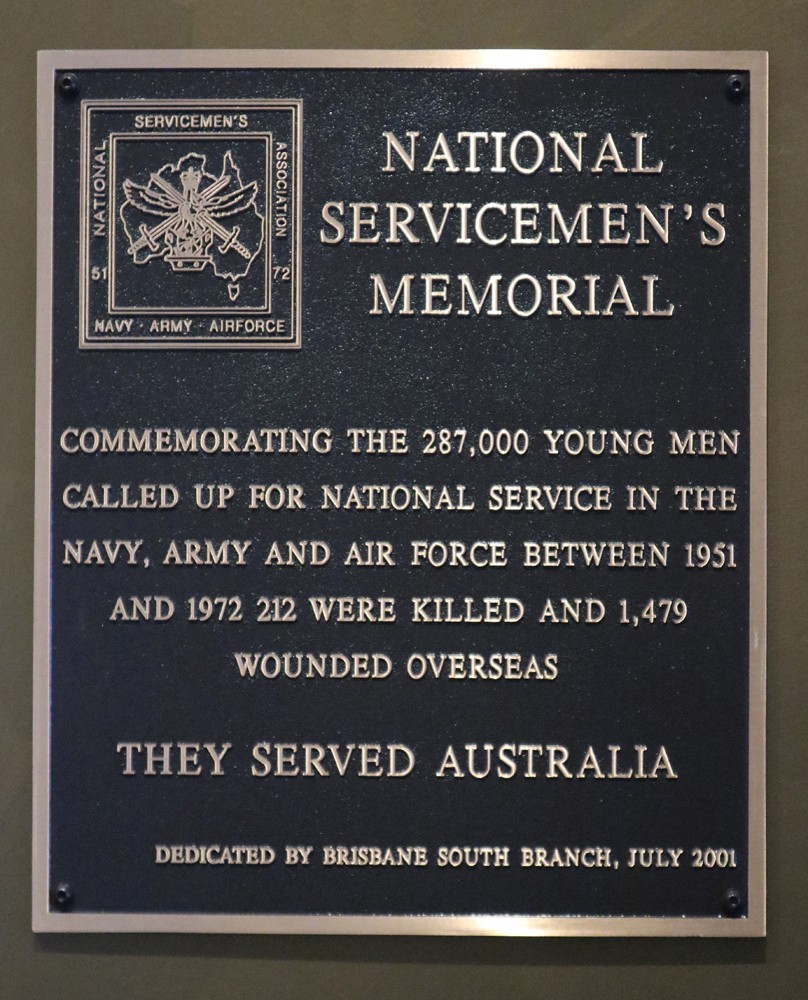
National Servicemen's Memorial Plaque, Anzac Square Memorial Galleries, photo taken by Gallery staff.
Another task the National Servicemen’s Association has undertaken is to produce a Nominal Roll where they hope to list all those who served under these two schemes. The Nominal Roll enables National Servicemen to record their own details of service and to look up the service details of others. This Nominal Roll is now accessible through the Anzac Square website: https://www.anzacsquare.qld.gov.au/national-service-nominal-roll
We encourage you to visit the site where you can search for family members or friends who served as Nashos. You are also able to download a National Service Record for the individuals and suggest amendments to their service information if needed. Should the person you are searching for not appear on the roll, there is an option to add their name and service details. Your contributions will ensure the accuracy and completeness of this important national document.
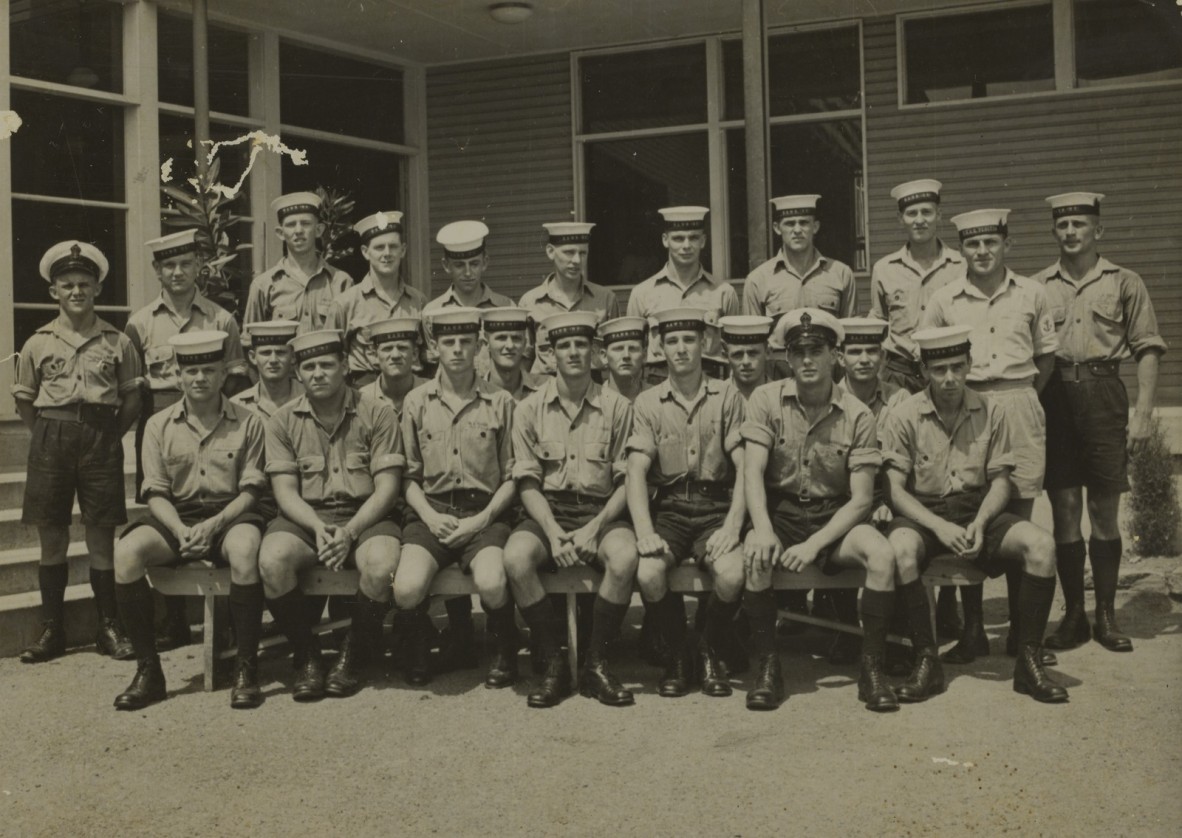
Intake photo of Navy National Servicemen of the HMAS Penguin, ca.1955-1956. 32648 William Malcolm Parker Collection, Brisbane John Oxley Library, State Library of Queensland.
The following State Library digital stories and oral histories contain accounts about the experiences in the Australian Defence Force of Australian National Servicemen: Bruce Reedman, John Tate, Alex Garlin, Geoffrey Daly and Patrick Dunne. https://onesearch.slq.qld.gov.au/permalink/61SLQ_INST/dls06p/alma99183826920502061
To learn more about the ‘Chalkies’ visit Anzac Square Memorial Galleries and listen to Norm Hunter and Daryl Dymock’s digital stories, where they talk about their experiences as teachers in Papua New Guinea during their National Service.
Anzac Square Memorial Galleries are open 10am-4pm Sunday-Friday, excluding public holidays. Plan your trip here: https://www.anzacsquare.qld.gov.au/visit
Comments
Your email address will not be published.
We welcome relevant, respectful comments.